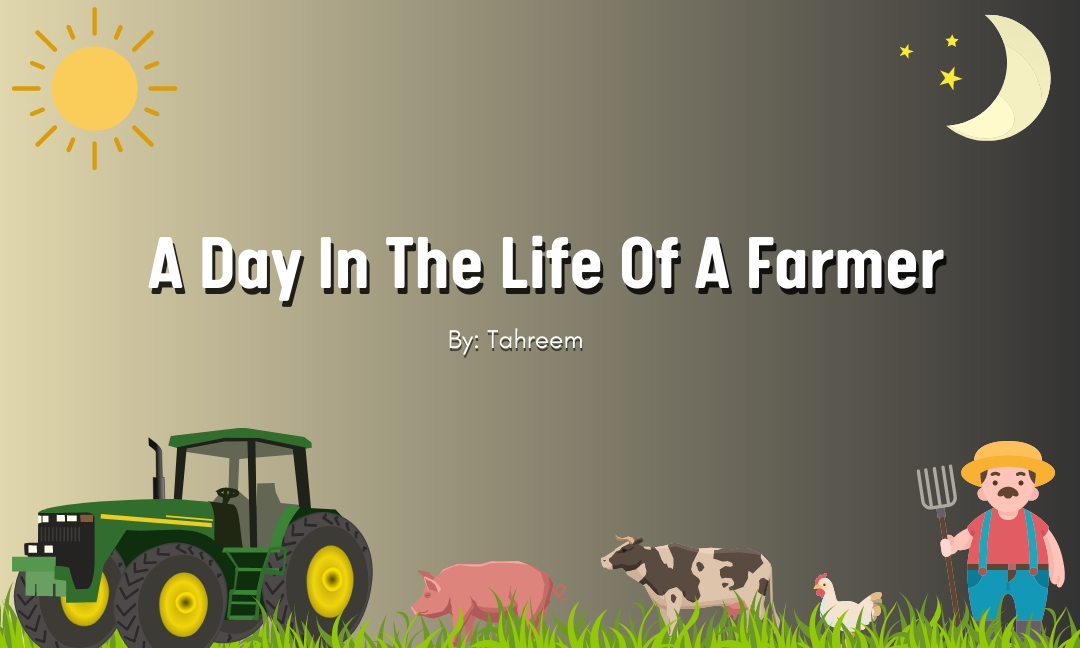Written by: Tahreem
Edited by: Maryam Nasser
Designed by: Melanie Hem
Published by: Kiritika Rana
When you take a bite of that crisp apple or slice up that delicious zucchini, it’s easy to overlook the efforts and hardwork that goes into cultivating it. Local farmers make it their biggest objective to grow and sell fresh, nutritious food⎯ food that would not be on our tables if it without their hard work and dedication.
Farmers are out in their fields and tunnels every day, working their tails off to grow our food! However, it is not as simple as planting a seed and watching it grow.
The Farmer’s Evolution
Did you know farming has been practiced for over 12,000 years? In fact, by the Bronze Age, humanity had become quite dependent on crop cultivation and irrigation.
Irrigation is a man-made method of applying specific amounts of water to land in order to produce crops. Importantly, irrigation was the foundation for the expansion of economies and societies all over the world as having crops allowed for eating and trading, while the irrigation process helped in regulating the temperature of livestock, overcoming dust, disposing of sewage, and later mining.
Similarly, animal husbandry (raising animals for meat, other materials, and for them to perform tasks) has been practiced for thousands of years. Overtime, humans have domesticated many animals, like dogs, goats, sheep, pigs, and horses. Since farmers have attuned these animals to their need (domestication), these animals are no longer considered “wild” creatures.
A farmer is someone who works in agriculture, cultivating crops and raising livestock to obtain food or raw materials. As a result, the farm’s employees are known as farm workers or farm hands. Older definitions, on the other hand, grant the title to anyone who promotes or improves the growth of plants, land, and/or crops, and/or raises animals (livestock or fish) through labor and attention.
Farming activities are determined by the type of farmer and includes:
Arable: When crops are grown in warm climates, on gently sloping land or a flat terrain with deep, fertile soil that is neither too wet nor too dry.
Pastoral: Raising animals in cold, wet climates that are unsuitable for crop cultivation(e.g.Farmers in Scotland’s Highlands)
Mixed: Growing crops and raising animals on the same land so that the animals may provide the manure to improve the soil quality for the crops.
Subsistence: Farmers who provide for themselves, producing materials and food for personal consumption and use.
Commercial: The activities on this type farm are carried out on a large scale in order to make money. (e.g monoculture)
Comprehensive and intensive: Preparing the land well in order to increase the amounts of crops that will grow.
Nomadic: Animals are relocated in search of pasture and water.
Sedentary: Cultivating the same land for multiple years on end. This practice boosted the maturing of early civilizations.
Poultry: Raising chickens and turkeys for meat and eggs. Free-range products are created by feeding these animals natural pasture.
Fish: Farmers who practice aquaculture raise many fish in large tanks or fish ponds.
The Timeline for a Farmers Day
6 a.m.: Get up and go! Right now, most farmers are already awake and at work, and they frequently start by opening tunnels and greenhouses so their crops do not overheat.
7 a.m.: Irrigation is especially important during times of drought or hot weather, so farmers maintain the health of crops by watering their fields by hand with a hose, sprinkler systems or drip irrigation.
8 a.m.: Got to weed! Weeding is strenuous work that consumes a significant amount of time for any farmer who follows natural farming practices.
9 a.m.: The harvesting begins! Though it is difficult work, finally seeing and collecting one’s crops is truly rewarding.
10 a.m.: After harvesting, farmers prepare the food by washing and/or packing items before they are sold, distributed or transported.
11 a.m.: It’s likely that something else needs to be weeded. Start working!
12 p.m.: Farmers who hand-fertilize their crops can use this time to do so, perhaps by placing eggshells around the base of tomato plants (for added nitrogen) or showering cucumber plants with liquefied sea kelp.
1 PM: Farmers always need to be aware of any pests coming to their crops. They might use this time to install new fencing or manually brush off eggs from the leaves of plants.
2 p.m.: It’s certainly getting warm outside by this time! Avoid the heat by sowing your next crop in the shade!
By mid-afternoon, farmers likely are feeling tired from a combination of the heat and their tasking job. It is important for us to appreciate farmers, as their occupation is time-consuming and requires dedication. In fact, farmers often work holidays and weekends to ensure the well-being of their crops!
As you know, farmers regularly face hard weather conditions, and weekends full of work. Nonetheless, they admit the satisfaction of cultivating fresh material makes all their difficulty worthwhile!
References
- A Day in the Life of a Farmer. (n.d.). The Produce Box. Retrieved May 15, 2023, from https://theproducebox.com/a-day-in-the-life-of-a-farmer/
- Farmer, A Day in the Life of Feeding the World. (n.d.). Gooroo. Retrieved May 15, 2023, from https://www.gooroo.com/blog/a-day-in-the-life-of-a-farmer/
- Samson, M. (2014, July 12). A Day in the Life of a Farm. The Kitchn. Retrieved May 15, 2023, from https://www.thekitchn.com/a-day-in-the-life-of-a-farm-a-new-generation-on-the-farm-205673
- WHAT A DAY IN THE LIFE OF A FARMER IS REALLY LIKE | Puli-Sistem. (n.d.). Puli-sistem. Retrieved May 15, 2023, from https://www.puli-sistem.net/what-a-day-in-the-life-of-a-farmer-is-really-like/

